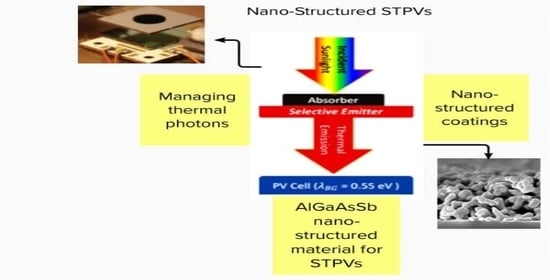Nanostructured AlGaAsSb Materials for Thermophotovoltaic Solar Cells Applications
Abstract
1. Introduction
2. Computational Method
3. XAFS Characterization
4. Thermoelectric and Optical Properties
5. Discussions
6. Conclusions and Way Forward
Author Contributions
Funding
Data Availability Statement
Acknowledgments
Conflicts of Interest
References
- AlGarni, H.; Kassem, A.; Awasthi, A.; Komljenovic, D.; Al-Haddad, K. A multicriteria decision making approach for evaluating renewable power generation sources in Saudi Arabia. Sustain. Energy Technol. Assess 2016, 16, 137–150. [Google Scholar]
- Nefzaoui, E.; Drevillon, J.; Joulain, K. Selective emitters design & optimization for thermophotovoltaic applications. J. Appl. Phys. 2012, 111, 084316. [Google Scholar]
- Bierman, D.M.; Lenert, A.; Chan, W.R.; Bhatia, B.; Celanović, I.; Soljačić, M.; Wang, E.N. Enhanced photovoltaic energy conversion using thermally based spectral shaping. Nat. Energy 2016, 1, 1–7. [Google Scholar] [CrossRef]
- Petela, R. Engineering Thermodynamics of Thermal Radiation for Solar Power Utilization, 1st ed.; McGraw-Hill Edition: New York, NY, USA, 2010. [Google Scholar]
- Hu, M.; Zhao, B.; Suhendri; Ao, X.; Cao, J.; Wang, Q.; Riffata, S.; Sua, Y.; Pei, G. Applications of radiative sky cooling in solar energy systems: Progress, challenges, and prospects. Renew. Sust. Energ. Rev. 2022, 160, 112304. [Google Scholar] [CrossRef]
- Chang, C.C.; Kort-Kamp, W.J.; Nogan, J.; Luk, T.S.; Azad, A.K.; Taylor, A.J.; Chen, H.T. High-temperature refractory metasurfaces for solar thermophotovoltaic energy harvesting. Nano Lett. 2018, 18, 7665–7673. [Google Scholar] [CrossRef]
- Dimroth, F.; Grave, M.; Beutel, P.; Fiedeler, U.; Karcher, C.; Tibbits, T.N.D.; Oliva, E.; Siefer, G.; Schachtner, M.; Wekkeli, A.; et al. Wafer bonded four-junction GaInP/GaAs//GaInAsP/GaInAs concentrator solar cells with 44.7% efficiency. Prog. Photovolt. 2014, 22, 277–282. [Google Scholar] [CrossRef]
- Trupke, T.; Green, M.A.; Würfel, P. Improving solar cell efficiencies by up-conversion of sub-band-gap light. J. Appl. Phys. 2002, 92, 4117–4122. [Google Scholar] [CrossRef]
- Swanson, R.M. A proposed thermophotovoltaic solar energy conversion system. Proc. IEEE 1979, 67, 446–447. [Google Scholar] [CrossRef]
- Inoue, T.; Watanabe, K.; Asano, T.; Noda, S. Near-field thermophotovoltaic energy conversion using an intermediate transparentsubstrate. Opt. Express 2018, 26, A192–A208. [Google Scholar] [CrossRef]
- Nam, Y.; Yeng, Y.X.; Lenert, A.; Bermel, P.; Celanovic, I.; Soljačić, M.; Wang, E.N. Solar thermophotovoltaic energy conversion systems with two-dimensional tantalum photonic crystal absorbers and emitters. Sol. Energy Mater. Sol. Cells 2014, 122, 287–296. [Google Scholar] [CrossRef]
- Sakakibara, R.; Stelmakh, V.; Chan, W.R.; Ghebrebrhan, M.; Joannopoulos, J.D.; Soljacic, M.; Čelanović, I. Practical emitters for thermophotovoltaics: A review. J. Photonics Energy 2019, 9, 032713. [Google Scholar] [CrossRef]
- Surendra Gupta, M.V.N.; Elikkottil, A.; Pesala, B. SiO2 grating-based photonic structures as ideal narrow band emitter for solar thermophotovoltaics application. In Advances in Energy Research; Springer: Singapore, 2020; Volume 1, pp. 29–35. [Google Scholar]
- Wang, Y.; Liu, H.; Zhu, J. Solar thermophotovoltaics: Progress, challenges, and opportunities. Appl. Mater. 2019, 7, 080906. [Google Scholar] [CrossRef]
- St-Gelais, R.; Bhatt, G.R.; Zhu, L.; Fan, S.; Lipson, M. Hot carrier-based near-field thermophotovoltaic energy conversion. ACS Nano 2017, 11, 3001–3009. [Google Scholar] [CrossRef] [PubMed]
- Gevorkyan, V.A.; Aroutiounian, V.M.; Gambaryan, K.M.; Kazaryan, M.S.; Touryan, K.J.; Wanlass, M.W. Liquid-phaseelectroepitaxialgrowthoflowband-gapp-InAsPSb/n-InAsandp-InAsP/n-InAsdiodeheterostructuresforthermo-photovoltaicapplication. Thin Solid Film. 2004, 451, 124–127. [Google Scholar] [CrossRef]
- Bauer, T.; Forbes, I.; Penlington, R.; Pearsall, N. The potential of thermophotovoltaic heat recovery for the glass industry. In AIP Conference Proceedings; American Institute of Physics: College Park, MD, USA, 2003; Volume 653, pp. 101–110. [Google Scholar]
- Wang, C.A. Antimony-based III–V thermophotovoltaic materials and devices. In AIP Conference Proceedings; American Institute of Physics: New York, NY, USA, 2004; Volume 738, pp. 255–266. [Google Scholar]
- Leenheer, A.J.; Narang, P.; Lewis, N.S.; Atwater, H.A. Solar energy conversion via hot electron internal photoemission in metallic nanostructures: Efficiency estimates. J. Appl. Phys. 2014, 115, 134301. [Google Scholar] [CrossRef]
- Teofilo, V.L. Thermophotovoltaic energy conversion for space applications. In AIP Conference Proceeings; American Institute of Physics: New York, NY, USA, 2006. [Google Scholar] [CrossRef]
- Huang, R.K.; Ram, R.J.; Manfra, M.J.; Connors, M.K.; Missaggia, L.J.; Turner, G.W. Heterojunction thermophotovoltaic devices with high voltage factor. J. Appl. Phys. 2007, 101, 046102. [Google Scholar] [CrossRef]
- Mauk, M.G.; Andreev, V.M. GaSb-related materials for TPV cells. Semicond. Sci. Technol. 2003, 18, S191. [Google Scholar] [CrossRef]
- Wang, C.A.; Vineis, C.J.; Choi, H.K.; Connors, M.K.; Huang, R.K.; Danielson, L.R.; Belenky, G. Monolithically series-interconnected GaInAsSb/AlGaAsSb/GaSb thermophotovoltaic devices with an internal back surface reflector formed by wafer bonding. In AIP Conference Proceedings; American Institute of Physics: New York, NY, USA, 2003; Volume 653, pp. 324–334. [Google Scholar]
- Wang, C.A.; Shiau, D.A.; Donetsky, D.; Anikeev, S.; Belenky, G.; Luryi, S. Extremely low surface recombination velocity in GaInAsSb/AlGaAsSb heterostructures. Appl. Phys. Lett. 2005, 86, 101910. [Google Scholar] [CrossRef]
- Motyka, M.; Janiak, F.; Sęk, G.; Misiewicz, J.; Moiseev, K.D. Temperature dependence of the energy gap and spin-orbit splitting in a narrow-gap InGaAsSb solid solution. Appl. Phys. Lett. 2012, 100, 211906. [Google Scholar] [CrossRef]
- Tang, A.; Cai, T.; Huang, Q.; Deng, J.; Pan, J. Numerical study on energy conversion performance of micro-thermophotovoltaic system adopting a heat recirculation micro-combustor. Fuel Process. Technol. 2018, 180, 23–31. [Google Scholar] [CrossRef]
- Rodriguez, J.B.; Cerutti, L.; Tournié, E. GaSb-based, 2.2 μ m type-I laser fabricated on GaAs substrate operating continuous wave at room temperature. Appl. Phys. Lett. 2009, 94, 023506. [Google Scholar] [CrossRef]
- Ilahi, S.; Yacoubi, N.; Genty, F. Photothermal deflection technique investigation of thermal annealing effects of AlGaAsSb/GaSb laser structure: Non-radiative recombination parameters enhancement. Mater. Res. Bull. 2018, 106, 332–336. [Google Scholar] [CrossRef]
- Peng, Q.; Yang, W.; Jiaqiang, E.; Xu, H.; Li, Z.; Yu, W.; Wu, Y. Experimental investigation on premixed hydrogen/air combustion in varied size combustors inserted with porous medium for thermophotovoltaic system applications. Energy Convers. Manag. 2019, 200, 112086. [Google Scholar] [CrossRef]
- Lu, Q.; Beanland, R.; Montesdeoca, D.; Carrington, P.J.; Marshall, A.; Krier, A. Low bandgap GaInAsSb thermophotovoltaic cells on GaAs substrate with advanced metamorphic buffer layer. Sol. Energy Mater. Sol. Cells 2019, 191, 406–412. [Google Scholar] [CrossRef]
- Yu, H.; Liu, D.; Yang, Z.; Duan, Y. Simple Rectangular Gratings as a Near-Field “Anti-Reflection” Pattern for GaSbTPV Cells. Sci. Rep. 2017, 7, 1–10. [Google Scholar]
- Inoue, T.; Koyama, T.; Kang, D.D.; Ikeda, K.; Asano, T.; Noda, S. One-Chip Near-Field Thermophotovoltaic Device Integrating a Thin-Film Thermal Emitter and Photovoltaic Cell. Nano Lett. 2019, 19, 3948–3952. [Google Scholar] [CrossRef]
- Yu, H.; Duan, Y.; Yang, Z. Selectively enhanced near-field radiative transfer between plasmonic emitter and GaSb with nanohole and nanowire periodic arrays for thermophotovoltaics. Int. J. Heat Mass Transf. 2018, 123, 67–74. [Google Scholar] [CrossRef]
- Parrott, B.; Zanini, P.C.; Shehri, A.; Kotsovos, K.; Gereige, I. Automated, robotic dry-cleaning of solar panels in Thuwal, Saudi Arabia using a silicone rubber brush. Sol. Energy 2018, 171, 526–533. [Google Scholar] [CrossRef]
- Liu, B.; Wang, C.; Bazri, S.; Badruddin, I.A.; Orooji, Y.; Saeidi, S.; Mahian, O. Optical properties and thermal stability evaluation of solar absorbers enhanced by nanostructured selective coating films. Powder Technol. 2021, 377, 939–957. [Google Scholar] [CrossRef]
- Omair, Z.; Scranton, G.; Pazos-Outón, L.M.; Xiao, T.P.; Steiner, M.A.; Ganapati, V.; Yablonovitch, E. Ultraefficient thermophotovoltaic power conversion by band-edge spectral filtering. Proc. Natl. Acad. Sci. USA 2019, 116, 201903001. [Google Scholar] [CrossRef]
- Jacak, J.E.; Jacak, W.A. Routes for metallization of perovskite solar cells. Materials 2022, 15, 2254. [Google Scholar] [CrossRef] [PubMed]
- Garín, M.; Hernandez, D.; Trifonov, T.; Alcubilla, R. Three-dimensional metallo-dielectric selective thermal emitters with high-temperature stability for thermophotovoltaic applications. Sol. Energy Mater. Sol. Cells 2015, 134, 22–28. [Google Scholar] [CrossRef]
- Kerschaver, E.V.; Beaucarne, G. Back-contact solar cells: A review. Prog. Photovolt. 2006, 14, 107–123. [Google Scholar] [CrossRef]
- Xuan, Y.; Chen, X.; Han, Y. Design and analysis of solar thermophotovoltaic systems. Renew. Energy 2011, 36, 374–387. [Google Scholar] [CrossRef]
- Hassan, S.; Doiron, C.F.; Naik, G.V. Optimum selective emitters for efficient thermophotovoltaic conversion. Appl. Phys. Lett. 2020, 116, 023903. [Google Scholar] [CrossRef]
- Fan, T.; Tian, C.; Cui, M.; Wei, T.; Liu, Z.; Wang, Y. Ga0.84In0.16As0.14Sb0.86/InAs0.91Sb0.09 dual-junction device for thermophotovoltaic energy conversion. IEEE Trans. Electron. Dev. 2020, 67, 4820–4826. [Google Scholar] [CrossRef]
- Powell, M.J.; Quesada-Cabrera, R.; Taylor, A.; Teixeira, D.; Papakonstantinou, I.; Palgrave, R.G.; Parkin, I.P. Intelligent multifunctional VO2/SiO2/TiO2 coatings for self-cleaning, energy-saving window panels. Chem. Mater. 2016, 28, 1369–1376. [Google Scholar] [CrossRef]
- Hohenberg, P.; Kohn, W.J.P.R. Density functional theory (DFT). Phys. Rev. 1964, 136, B864. [Google Scholar] [CrossRef]
- Blaha, P.; Schwarz, K.; Madsen, G.K.H.; Kvasnicka, D.; Luitz, J. Wien2k an Augmented Plane Wave Plus Local Orbitals Program for Calculating Crystal Properties; University of Technology: Vienna, Austria, 2001; ISBN 3-9501031-1-2. [Google Scholar]
- Perdew, J.P.; Burke, K.; Ernzerhof, M. Generalized gradient approximation made simple. Phys. Rev. Lett. 1996, 77, 3865. [Google Scholar] [CrossRef]
- Singh, D. Plane Waves Pseudopotentials and the LAPW Method; Kluwer Academic: Boston, MA, USA, 1994. [Google Scholar]
- Blochl, E.; Jepsen, O.; Andersen, O.K. Projector augmented-wave method. Phys. Rev. B 1994, 49, 16223. [Google Scholar] [CrossRef]
- Blöchl, P.E. Car-Parrinello Projector Augmented Wave Method (CP-PAW). Phys. Rev B 1994, 50, 17953. [Google Scholar] [CrossRef] [PubMed]
- Monkhorst, H.J.; Pack, J.D. Special points for Brillouin-zone integrations. Phys. Rev. B 1976, 13, 5188. [Google Scholar] [CrossRef]
- Madsen, G.K.; Singh, D.J.; Boltz, T. A code for calculating band-structure dependent quantities. Comput. Phys. Commun. 2006, 175, 67–71. [Google Scholar] [CrossRef]
- Slack, G.A. The thermal conductivity of nonmetallic crystals. Solid State Phys. 1979, 34, 1–71. [Google Scholar]
- Ankudinov, A.L.; Rehr, J.J. Relativistic calculations of spin-dependent x-ray-absorption spectra. Phys. Rev. B 1997, 56, R1712. [Google Scholar] [CrossRef]
- Newville, M. IFEFFIT: Interactive XAFS analysis and FEFF fitting. J. Synchrotron Rad. 8 2001, 8, 322–324. [Google Scholar] [CrossRef]
- Newville, M. Fundamentals of XAFS. Rev. Miner. Geochem. 2014, 78, 33–74. [Google Scholar] [CrossRef]
- Ozkendir, O.M. Electronic structure study of Sn-substituted Li2MnO3 cathode material. Mater. Today Commun. 2020, 24, 101241. [Google Scholar] [CrossRef]
- Miyazaki, H.; Ozkendir, O.M.; Gunaydin, S.; Watanabe, K.; Soda, J.; Tang, Z.M.; Zhang, R.; Zhou, L.; Chen, Y.; Zhao, S.; et al. Growth of GaSb crystal and evaluation of its thermo electric properties along (111) plane. Cryst. Res. Technol. 2020, 55, 1900156. [Google Scholar]
- Kim, Y.J.; Zhao, L.D.; Kanatzidis, M.G.; Seidman, D.N. Analysis of nanoprecipitates in a Na-doped PbTe–SrTe thermoelectricmaterial with a high figure of merit. ACS Appl. Mater. Interfaces 2017, 9, 21791–21797. [Google Scholar] [CrossRef]
- Sarkar, S.; Hua, X.; Hao, S.; Zhang, X.; Bailey, T.P.; Slade, T.J.; Kanatzidis, M.G. Dissociation of GaSb in n-TypePbTe: Off-Centered Gallium Atomand Weak Electron–Phonon Coupling Provide High Thermoelectric Performance. Chem. Mater. 2021, 33, 1842–1851. [Google Scholar] [CrossRef]
- Dresselhaus, M.S.; Chen, G.; Tang, M.Y.; Yang, R.G.; Lee, H.; Wang, D.Z.; Gogna, P. New directions for low-dimensional thermoelectric materials. Adv. Mater. 2007, 19, 1043–1053. [Google Scholar] [CrossRef]
- Liu, W.S.; Lin, H.C.; Liu, R.Y. Capping vertically aligned InGaAs/GaAs (Sb) quantum dots with a AlGaAsSb spacer layer in intermediate-band solar cell devices. Prog. Photovolt. Res. Appl. 2017, 25, 76–86. [Google Scholar] [CrossRef]
- Ilahi, S.; Yacoubi, N.; Genty, F. Thermal annealing effects on AlGaAsSb/GaSb laser structure: Bandgap energy blueshift and thermal conductivity enhancement. Opt. Mater. 2017, 69, 226–229. [Google Scholar] [CrossRef]
- Al-Omari, S.A.B.; Qureshi, Z.A.; Elnajjar, E.; Mahmoud, F. A heat sink integrating fins within high thermal conductivity phase change material to cool high heat-flux heat sources. Int. J. Therm. Sci. 2022, 172, 107190. [Google Scholar] [CrossRef]
- Luo, H.; Xie, S.; Chai, X.; Huang, S.; Zhang, Y.; Xu, Y.; Niu, Z. High order DBR GaSb based single longitude mode diode lasers at 2 μm wavelength. J. Semicond. 2018, 39, 104007. [Google Scholar] [CrossRef]
- Ilahi, S.A.; Khalfaoui, A.; Genty, F.; Yacoubi, N. Significant improvement of thermal conductivity and bandgap energy blue shift in annealed GaInAsSb/GaSb. Opt. Laser Technol. 2021, 137, 106819. [Google Scholar] [CrossRef]
- Rogalski, A.; Kopytko, M.; Martyniuk, P. InAs/GaSb type-II super lattice infrared detectors: Three decades of development. In Infrared Technology and Applications XLIII; SPIE: Paris, France, 2017; Volume 10177, pp. 211–223. [Google Scholar]
- Liu, C.; An, X.X.; Cui, Y.F.; Xie, K.F.; Dong, W.K. Novel structurally characterized hetero-bimetallic [Zn (II) 2M (II)](M= Ca and Sr) bis (salamo)-type complexes: DFT calculation, Hirshfeld analyses, antimicrobial and fluorescent properties. Appl. Organomet. Chem. 2020, 34, e5272. [Google Scholar] [CrossRef]
- Ni, Q.; Sabbaghi, P.; Wang, L. Optoelectronic analysis of spectrally selective nanophotonic metafilm cell for thermophotovoltaic energy conversion. J. Quant. Spectrosc. Radiat. Transf. 2021, 268, 107625. [Google Scholar] [CrossRef]
- Chen, F.R.; An, G.; Xu, Z.G. Performance analysis of three-body near-field thermophotovoltaic systems with an intermediate modulator. J. Quant. Spectrosc. Radiat. Transf. 2021, 258, 107395. [Google Scholar] [CrossRef]
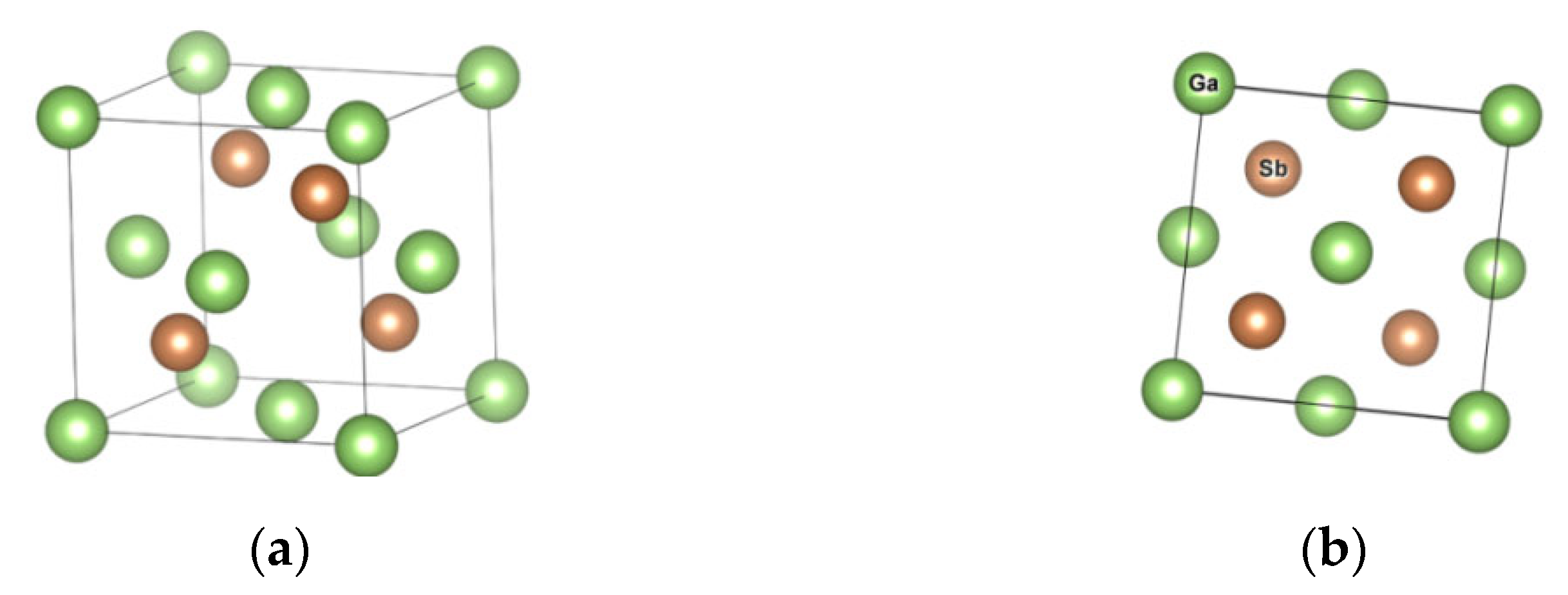
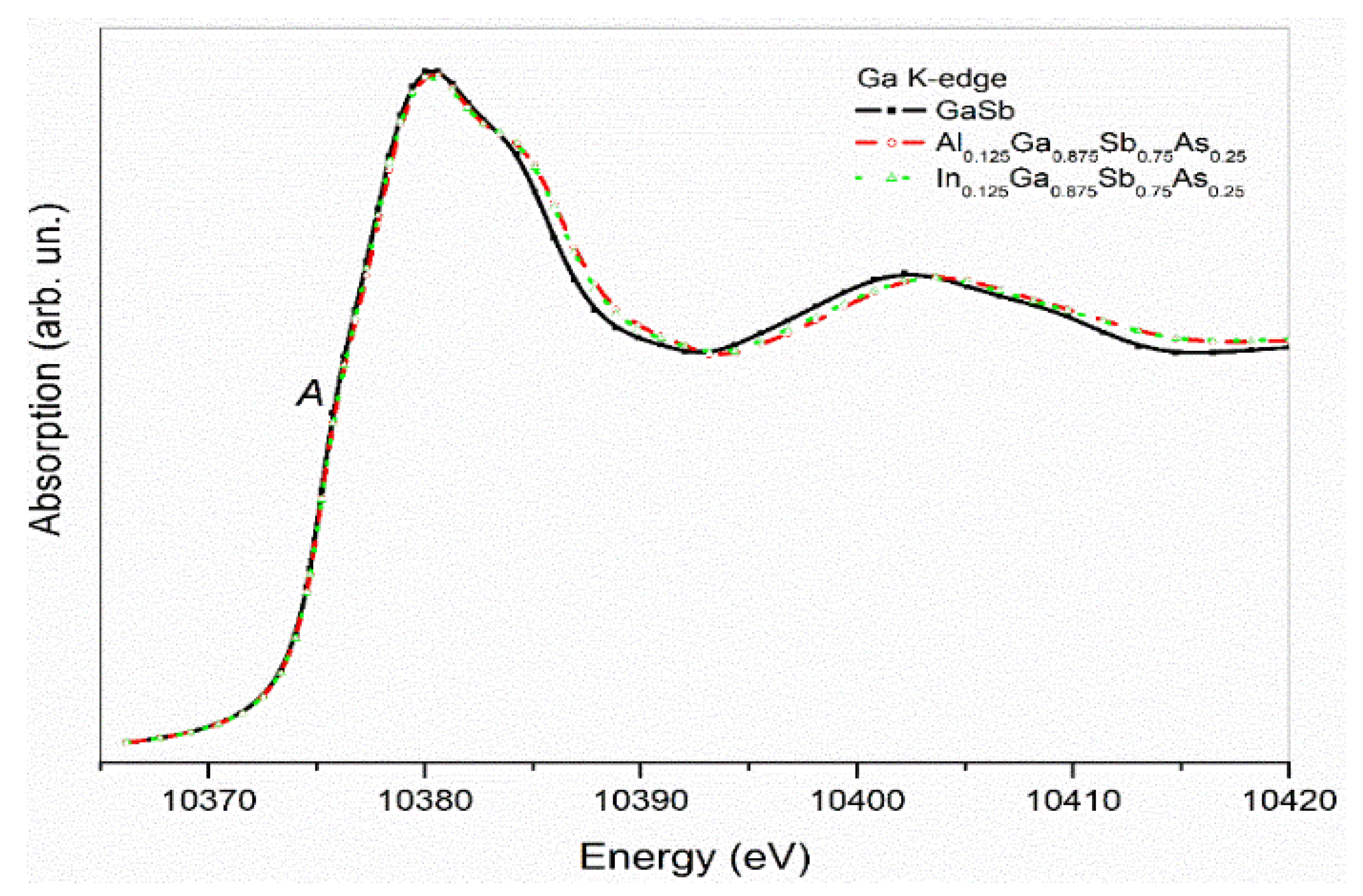
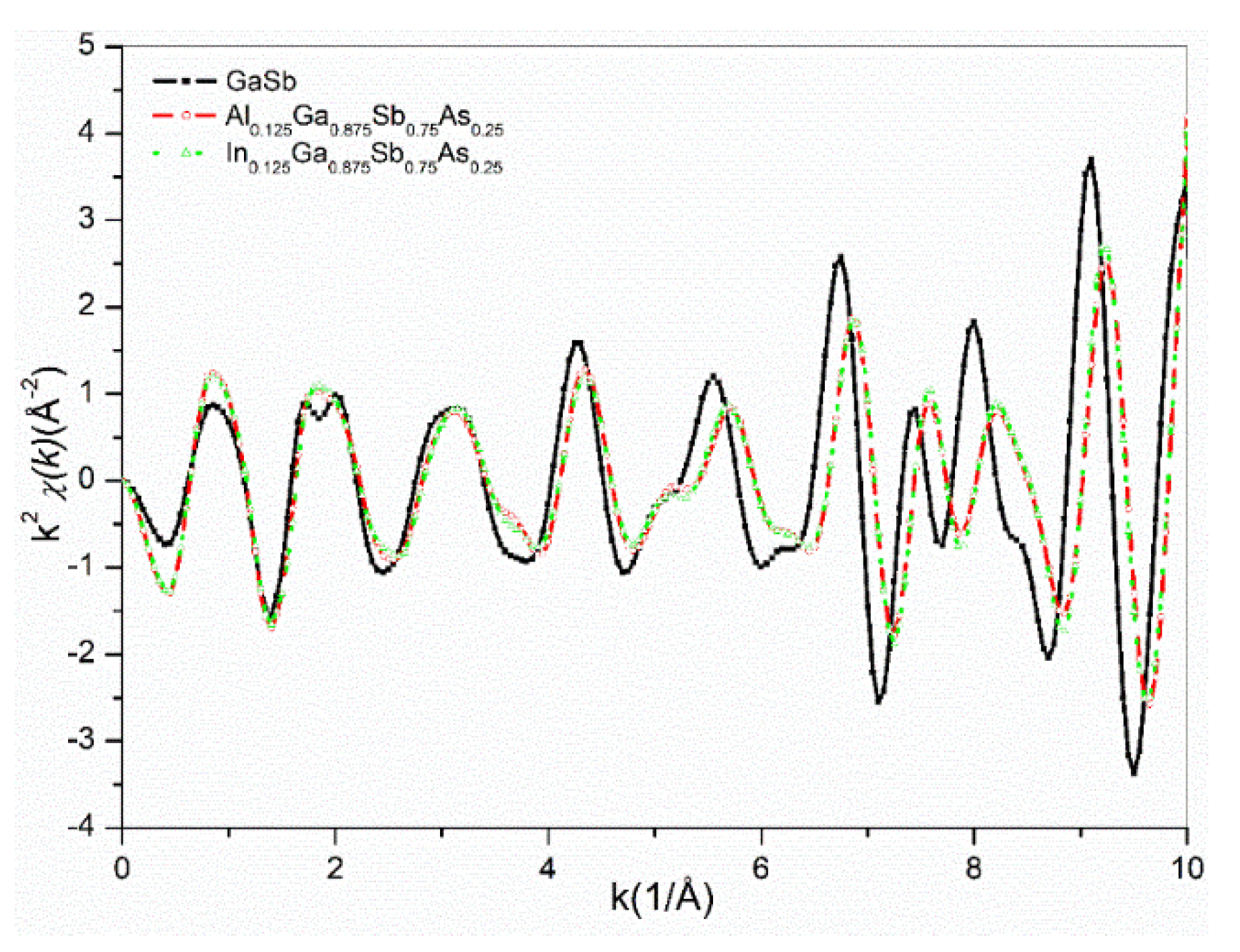
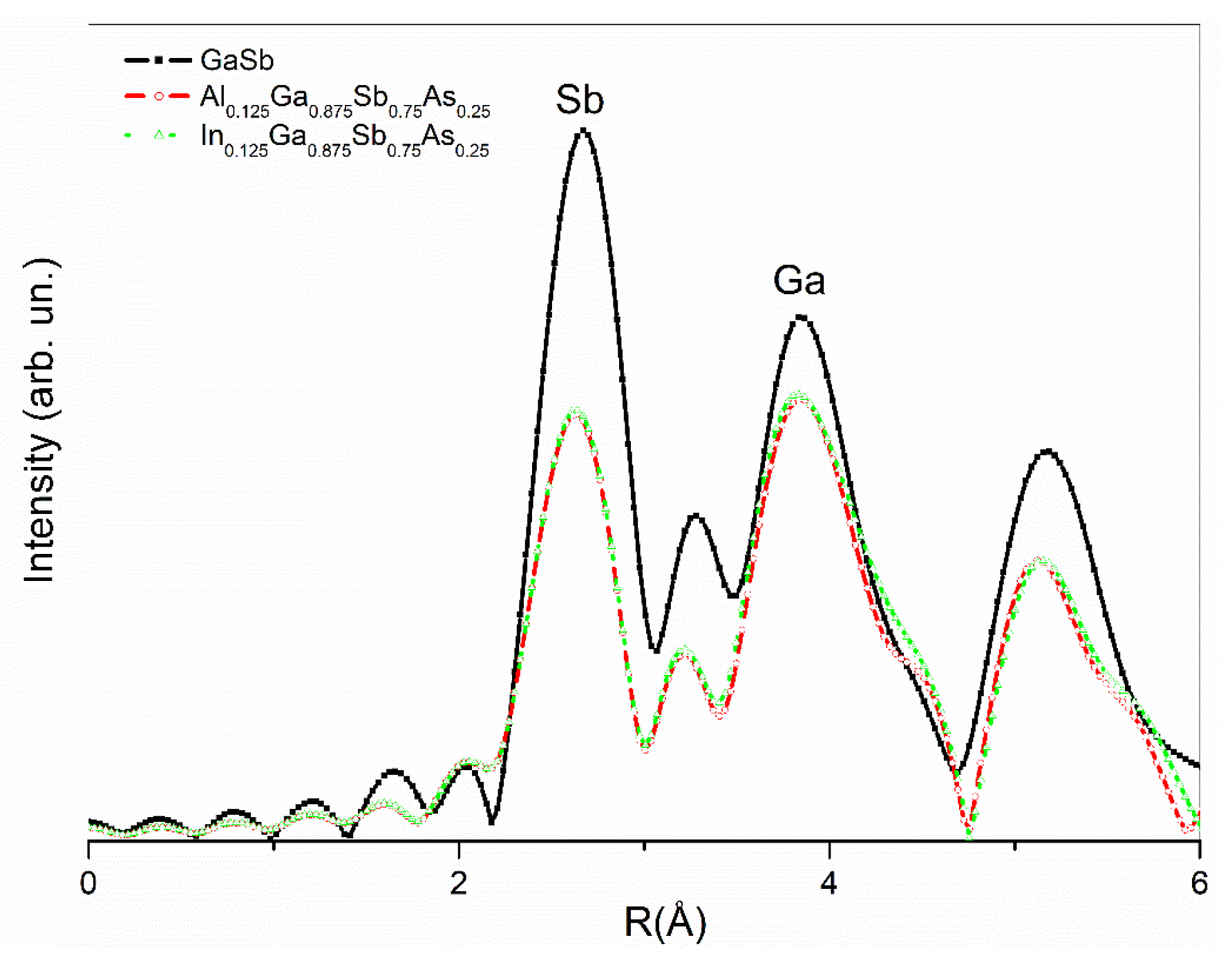
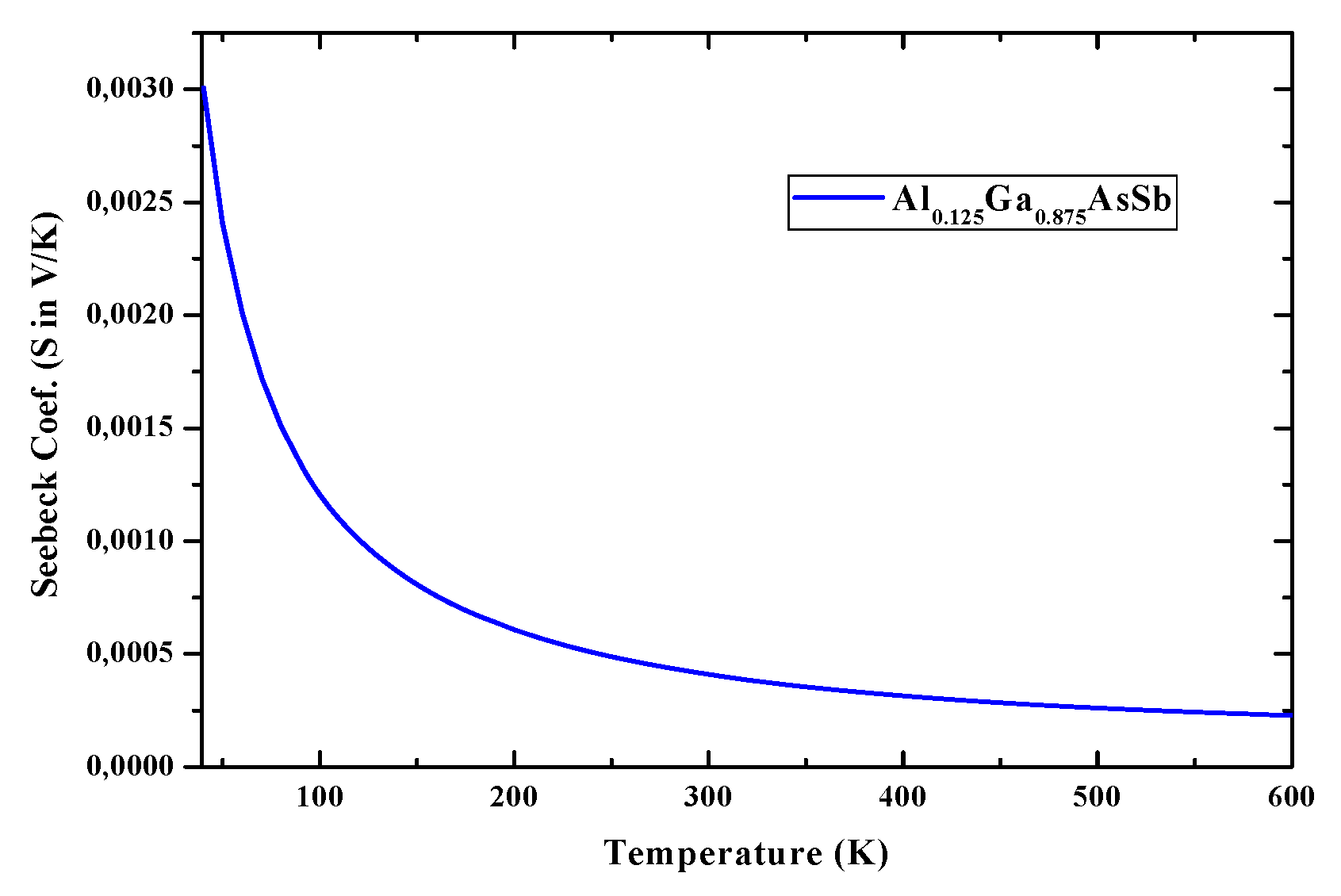
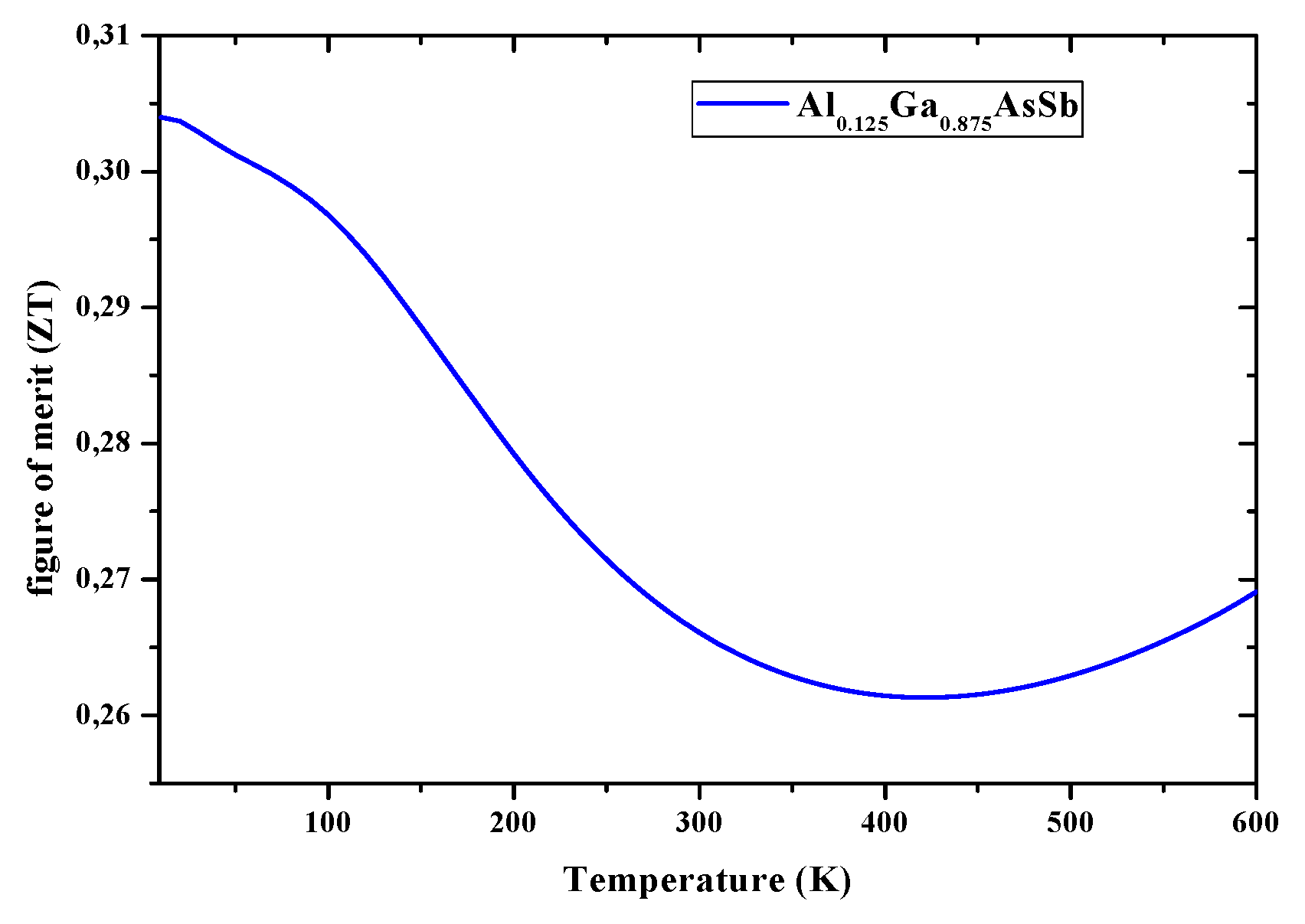
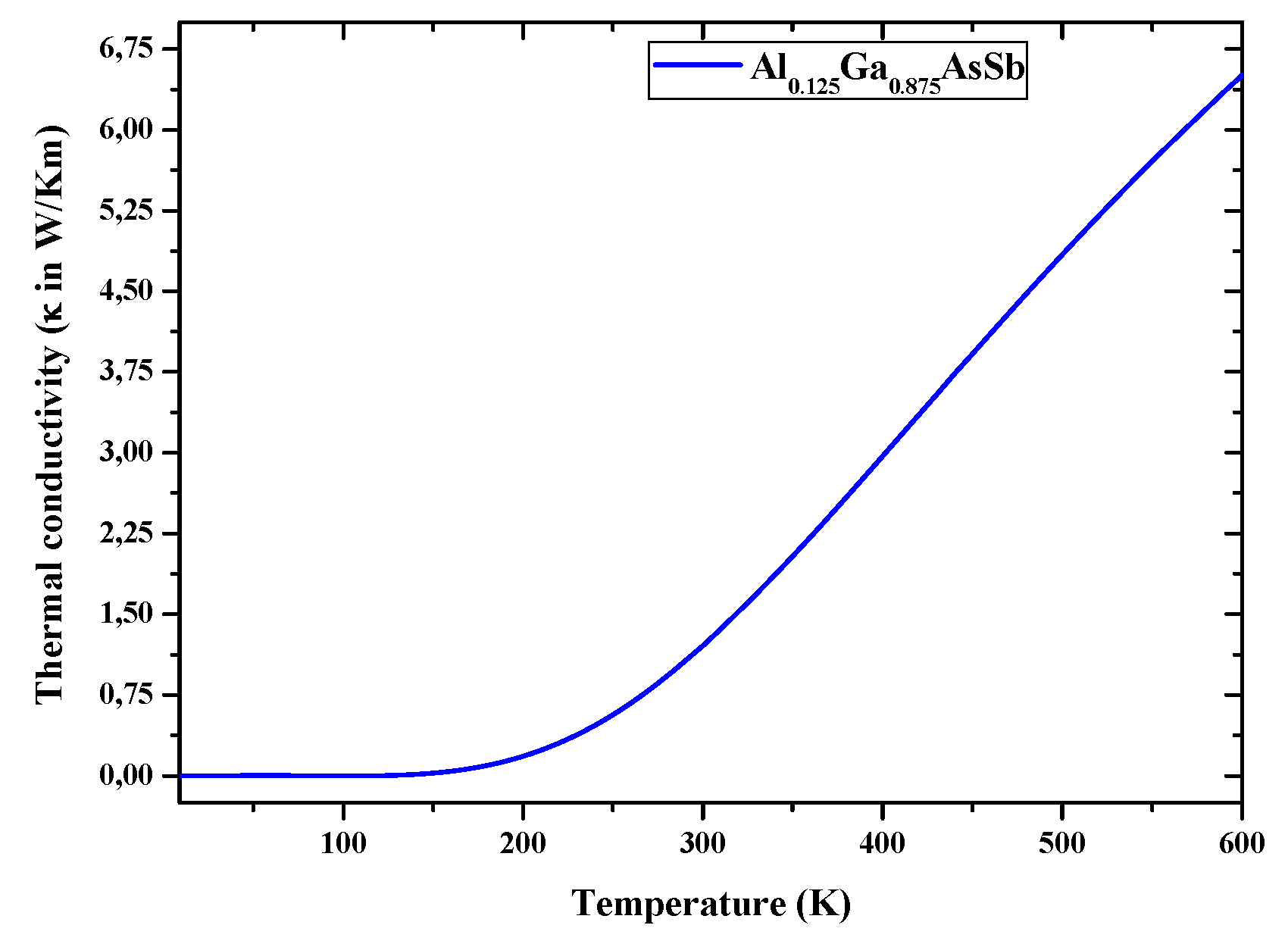
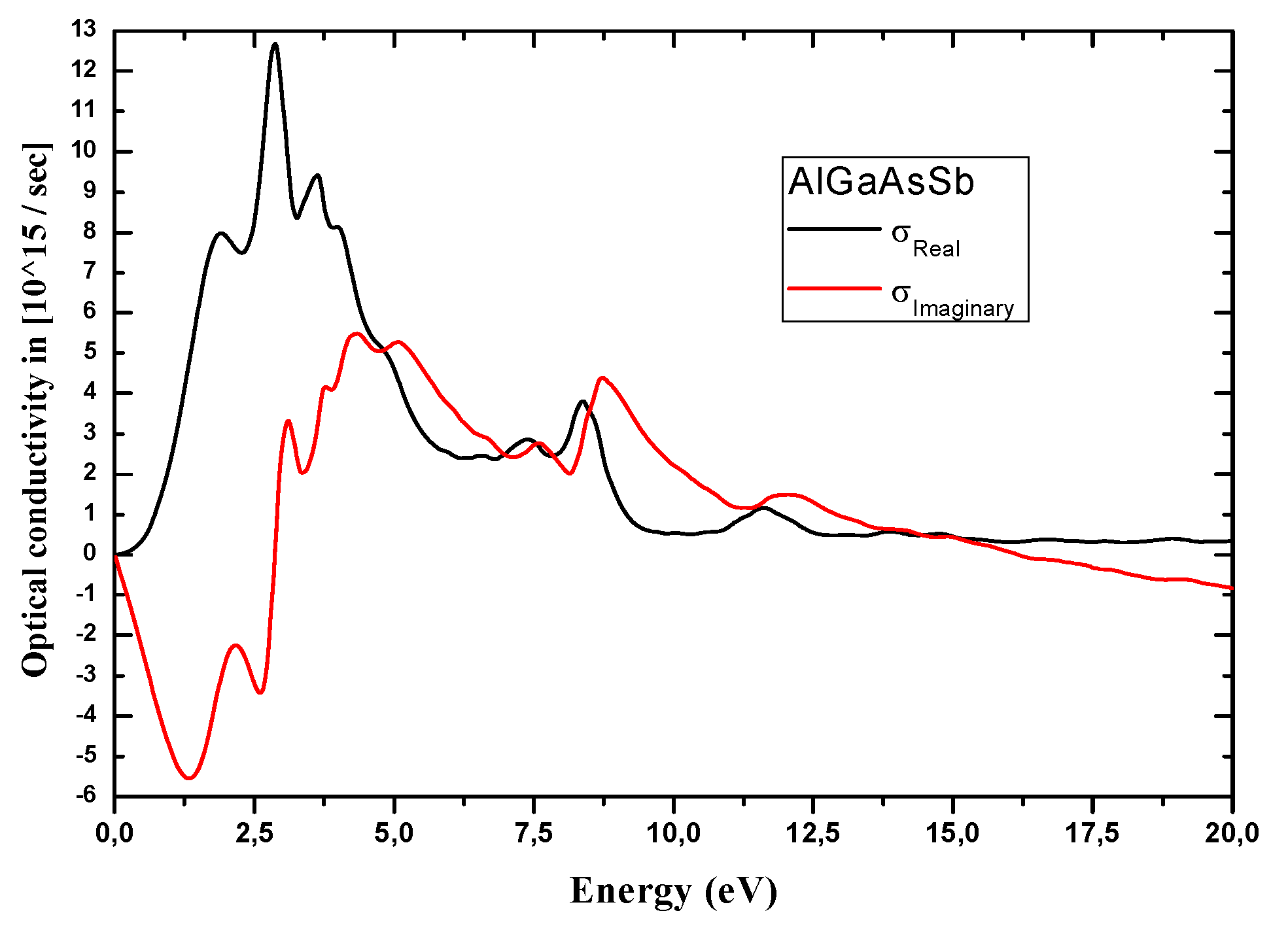
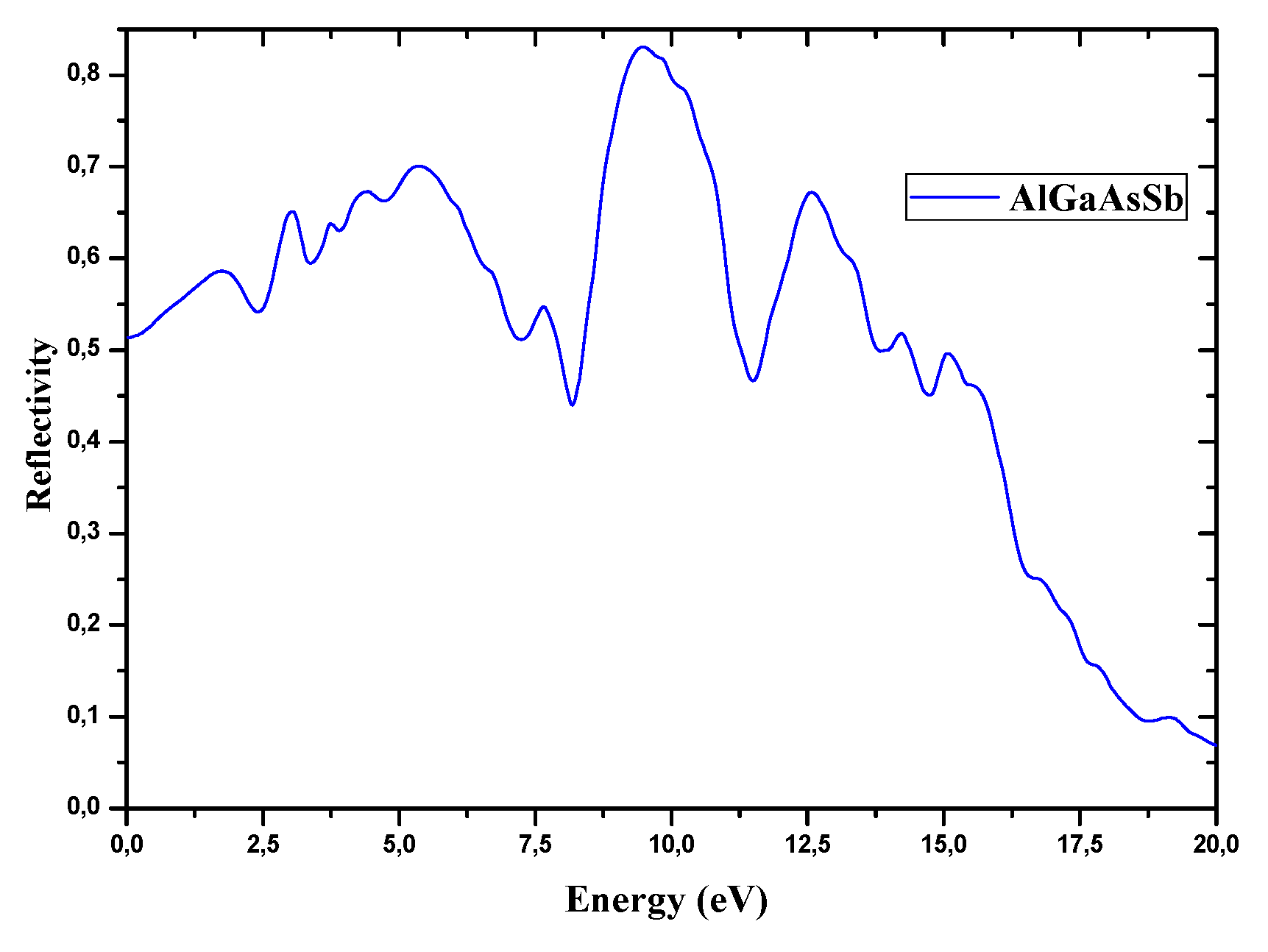
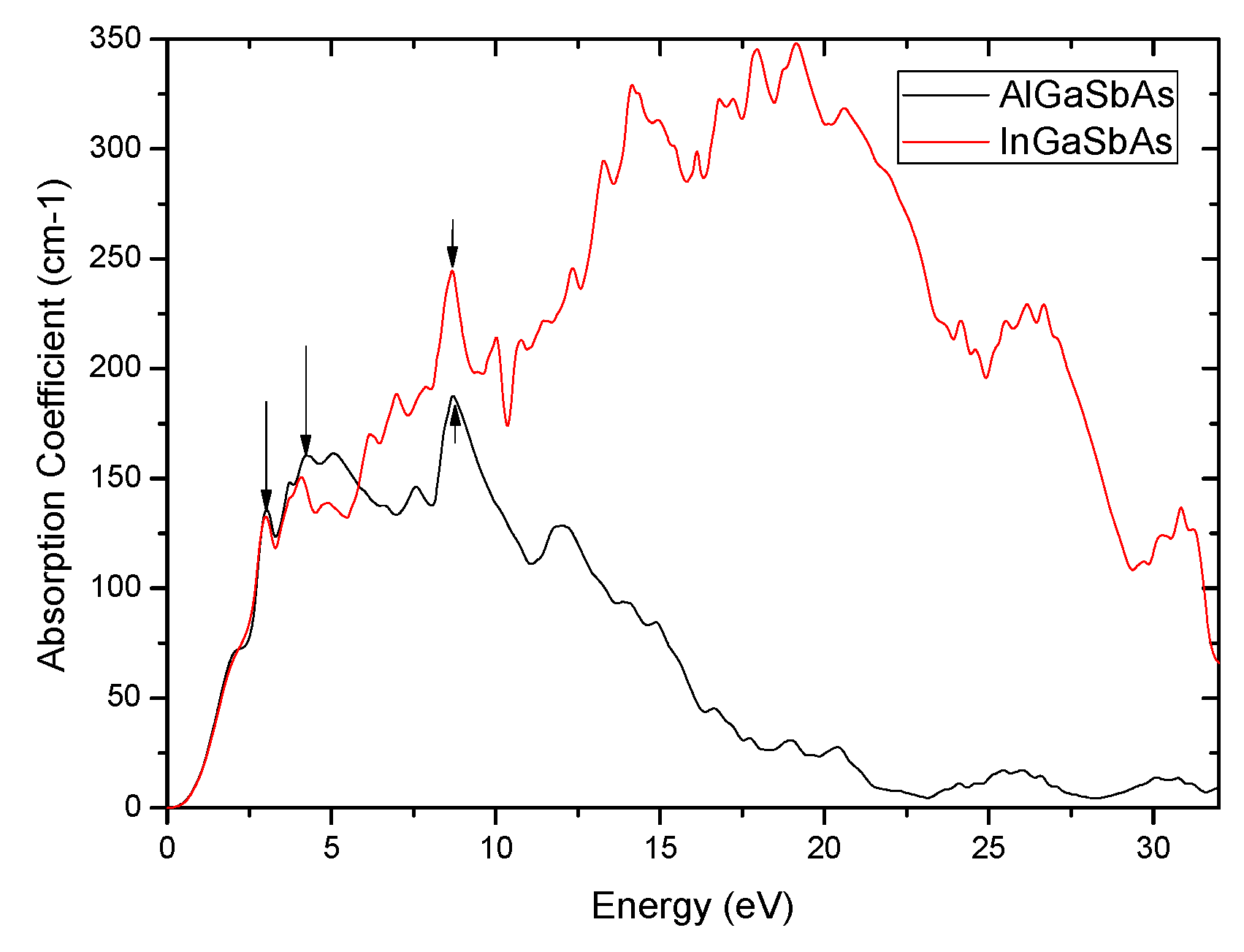
Publisher’s Note: MDPI stays neutral with regard to jurisdictional claims in published maps and institutional affiliations. |
© 2022 by the authors. Licensee MDPI, Basel, Switzerland. This article is an open access article distributed under the terms and conditions of the Creative Commons Attribution (CC BY) license (https://creativecommons.org/licenses/by/4.0/).
Share and Cite
Bensenouci, D.; Merabet, B.; Ozkendir, O.M.; Maleque, M.A. Nanostructured AlGaAsSb Materials for Thermophotovoltaic Solar Cells Applications. Nanomaterials 2022, 12, 3486. https://doi.org/10.3390/nano12193486
Bensenouci D, Merabet B, Ozkendir OM, Maleque MA. Nanostructured AlGaAsSb Materials for Thermophotovoltaic Solar Cells Applications. Nanomaterials. 2022; 12(19):3486. https://doi.org/10.3390/nano12193486
Chicago/Turabian StyleBensenouci, Djamel, Boualem Merabet, Osman M. Ozkendir, and Md A. Maleque. 2022. "Nanostructured AlGaAsSb Materials for Thermophotovoltaic Solar Cells Applications" Nanomaterials 12, no. 19: 3486. https://doi.org/10.3390/nano12193486
APA StyleBensenouci, D., Merabet, B., Ozkendir, O. M., & Maleque, M. A. (2022). Nanostructured AlGaAsSb Materials for Thermophotovoltaic Solar Cells Applications. Nanomaterials, 12(19), 3486. https://doi.org/10.3390/nano12193486






